This short article covers on how to read the modern bus ticket issued on all public buses.
Introduction
In Singapore, a bus ticket is issued after fare payment is made by cash. This is a small slip of paper printed with details such as place of boarding and the amount of fare tendered. As proof of payment, cash-paying passengers are required to produce the ticket during fare inspection, and not having a ticket / holding on to an expired ticket can result in a $20 fine.
Currently, there are two types of bus tickets being issued. The first is the older ink tickets, which are printed by the old fare validators. These tickets are printed on normal paper and then printed with ink. The second is the newer ‘thermal tickets’, printed on thermal paper by the newer and smaller orange thermal printers (hence identified by their glossy paper appearance). Heat is to create the text on the paper; however these tickets fade after time. The information presented on both kinds of tickets are the same.
How to read
Modern tickets have nine sets of information displayed on them. Here’s a picture for you to follow:
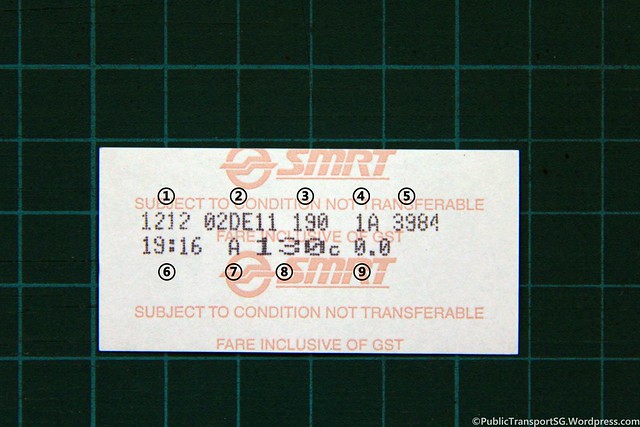
^ Standard ticket issued by SMRT Buses. SBS Transit buses use the same format.
| ① – Bus registration number
This shows the registration plate number of the bus which the ticket is issued. In this case, 1212 refers to TIB1212G, a Mercedes-Benz O405G. ② – Date This shows the date of ticket issue. 02DE11 refers to 2nd December 2011. All months are identified by their first two letters, with the exception of May (MY) and July (JY). As of 2020, July is printed as JL, but it is not known when the change took place. ③ – Bus Service The bus service on which the ticket is issued. In this case, it is Service 190. Non-basic services (i.e. Fast-Forward, Chinatown Direct, Night Riders / Nite Owls) may use different numbering schemes. ④ – Direction & Fare type The first number indicates direction of travel. 1 refers to direction 1, and 2 refers to direction 2. Loop services only print 1. Exceptions do exist. The second letter A indicates air-conditioned bus. N will indicate a non-air-conditioned bus. ⑤ – Ticket serial number These four-digits (3984) vary across tickets, and buses print them in numeric order. |
⑥ – Time of boarding
Time is displayed in the 24-hour format. In this case, 19:16 means 7:16pm. ⑦ – Fare category ‘A‘ refers to adult fare. ‘C’ would refer to Child fare, and ‘S’ would refer to Senior Citizen fare. A ‘P’ at the front stands for Peak hour. ⑧ – Fare tendered Amount of fare paid in cents, and does not include any excess fare tendered (e.g. paying with a $5 note on a basic service will only get you the maximum $2.20 ticket). 130c would be $1.30. ⑨ – Place of boarding This number corresponds to the bus stop (displayed as number of kilometers into the route) at which the commuter boarded. If we were to check for the bus stop at 0.0km in Direction 1 of service 190, it would correspond to Choa Chu Kang Bus Interchange. |
Older Bus Tickets
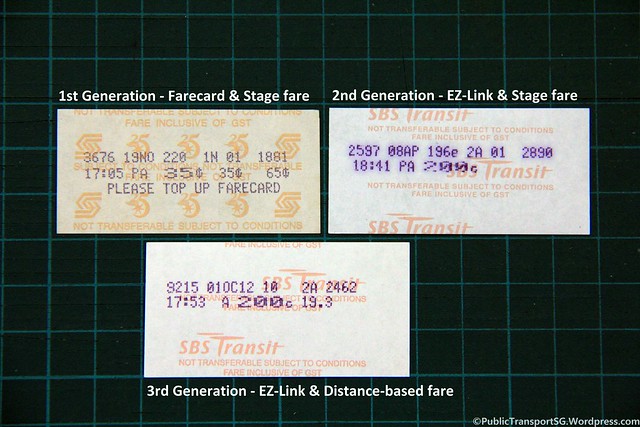
^ Different generations of bus tickets in the not-too-distant past
| ① – Bus registration number
Still the same four digits. Buses with less than four-digit registration plates will print zeros at the front. ② – Date Bus tickets in the past did not print out the year of issue ③ – Bus Service Basic-Plus bus services in the past often printed letter prefixes and suffixes where necessary, such as the 2nd-Gen Fast-Forward bus ticket. These were replaced with more obscure service codes with the introduction of the thermal ticket printer. ④ – Direction & Fare type As explained above. ⑤ – Ticket serial number As explained above. |
⑥ – Time of boarding
During the farecard era (1st-Gen), the time printed was not the time of bus boarding. The commuter had to make a valid bus transfer before the printed time to enjoy a transfer rebate. ⑦ – Fare category As explained above. Older tickets may have a ‘T’ at the front, indicating Transfer. ⑧ – Fare tendered Amount of fare paid in cents. The 1st-Gen bus ticket will receive special mention below. ⑨ – Place of boarding Present on the 3rd-Gen ticket, this was not printed during the 1st and 2nd-Gen tickets. |
Special Mention: 1st-Gen ⑧ Fare tendered
|
|
Bus Ticket Gallery:
| ① – Fast Forward 10e
② – Chinatown Direct CT18 ③ – Stadium Direct SS2 |
④ – Premium 538
⑤ – Nite Owl 4N ⑥ – NightRider NR7 |

^ Complimentary & Inspector Tickets
| ① – Complimentary Ride ticket
Usually issued when a bus breaks down to allow commuters to easily continue their journey. Entitles one to a complimentary ride onboard any bus service (operated by the same operator) exactly one month after the date of issue.
|
② – Inspector ticket
Not intended for public distribution. Drivers issue inspector tickets to ticket inspectors who would keep the ticket as a record of the buses they have inspected.
|
————————————————————————————————————————————

^ Coloured tickets used in the past
| ① – Chinatown Direct ticket
Yellow tickets were used on Chinatown Direct buses for a period of time before they were reverted back to the normal white tickets. ② – SBS Transit cross-border ticket Red tickets were used alongside Blue tickets on buses deployed to cross-border Service 170 to aid in identification when re-boarding the bus at the checkpoint after clearing customs. Service 160 also used red tickets. Bus was deployed to Chinatown Direct CT28 when ticket was printed. |
③ – SMRT cross-border ticket
Blue tickets were used both by SBS Transit and SMRT, and in SMRT’s case, for cross-border Service 950. Since TIB1000B is a Mercedes-Benz O405G that was never registered as a cross-border bus, one can deduce that the blue ticket roll was accidentally installed on the wrong bus. |
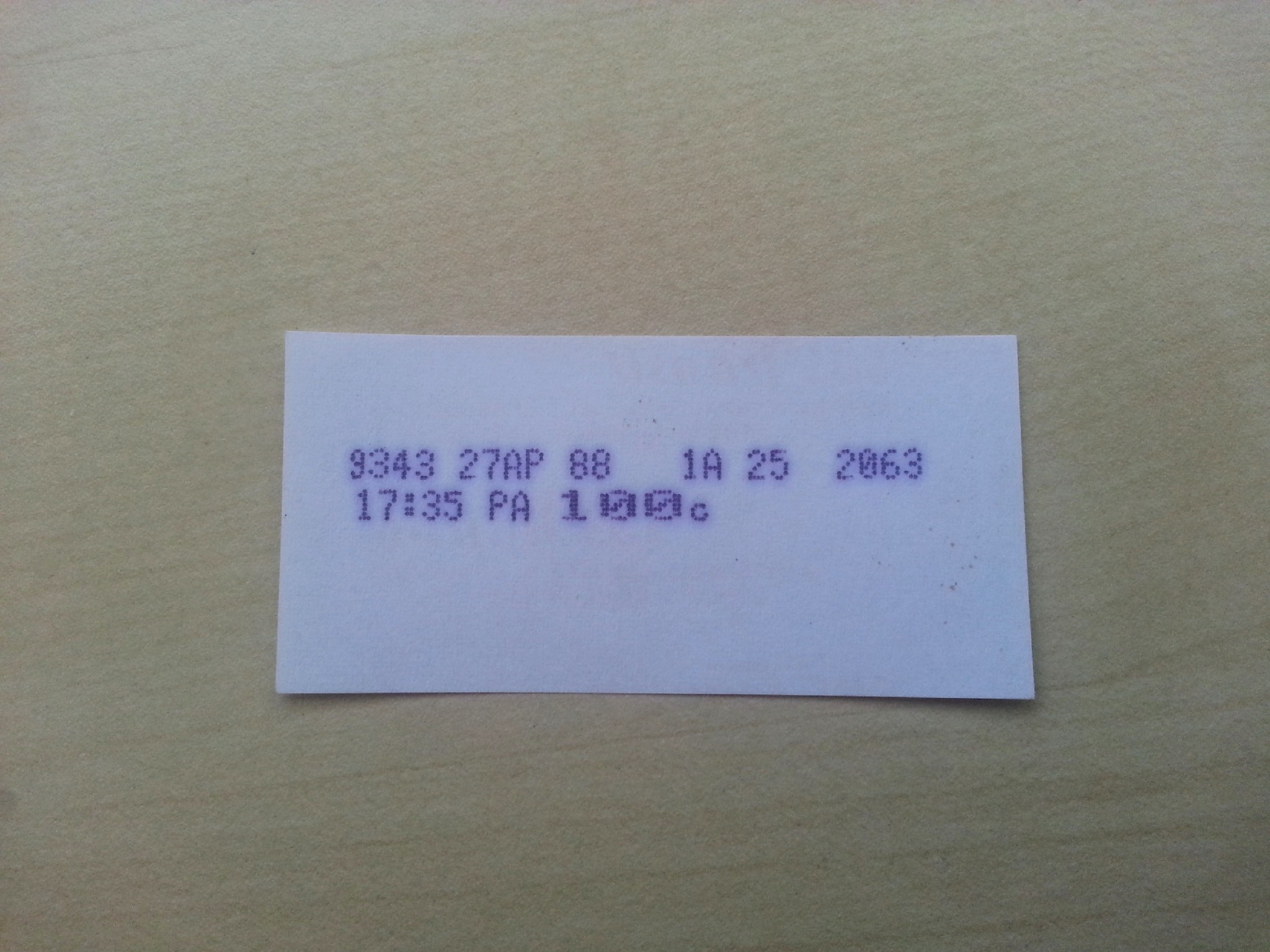 Others
Others
Details printed on the wrong side of the paper. The ticket roll was improperly installed inside the validator.
Here’s a related infographic from Joey Foo:

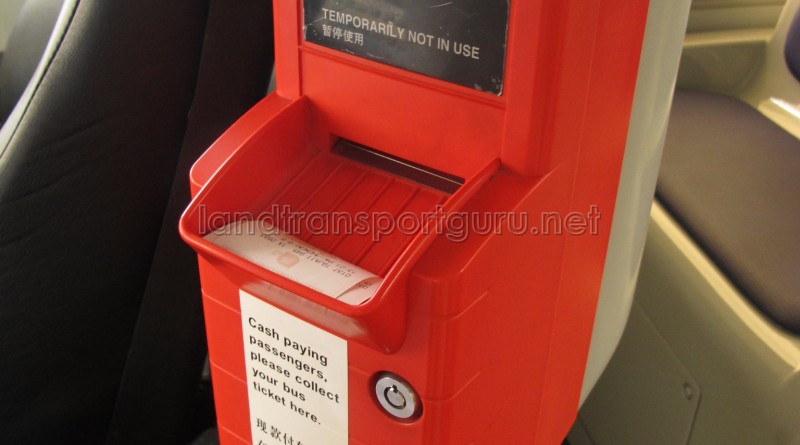
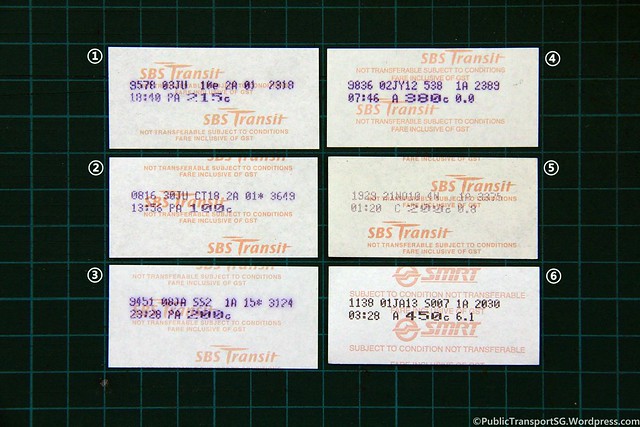
Can we use black pen to rewrite what has faded
Why got number like 01 on old ticket beside Direction & Fare type??